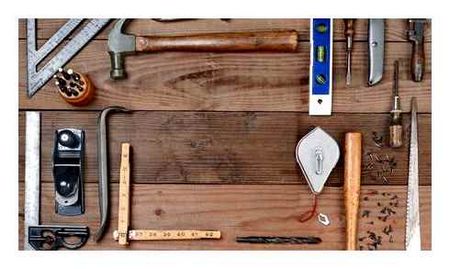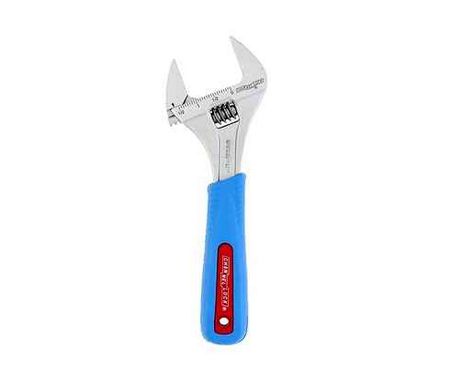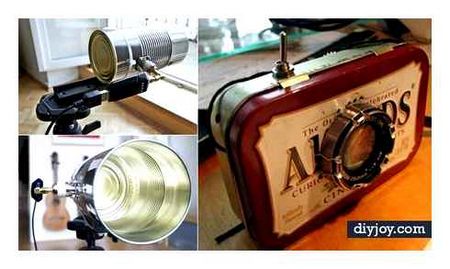DIY tools and gadgets with your own hands
Samodelkin create tools and devices
Master is not characterized by greed, which suffers from some craftsmen who do not want to share their findings with others and like a dog in the hay neither for themselves nor for people. And this self-taught inventor has come up with a great device, with which you will always be at your best and can even improve your standard of living. Yes, you can put on stream the production of such tools and sell it to all comers. Maybe this is too loud, but it is worth thinking about automation and mechanization of all routine work at home.
8 tools for the handyman.
You probably haven’t seen many of these. Cool tools create Samodelkin. These tools help to work more comfortably in the workshop. The video was shot on the channel Hands from the shoulders.
How to make a metal workbench with your own hands?
For carrying out locksmith work you will need a metal workbench. Its standard size: length 1,8-2,1 m, width. 0,7-0,8 m, height. 0,9-1,2 m. Making involves such steps:
- Assembling a workbench frame with longitudinal stiffening.
- Assemble and fasten 2 bollards in the form of a frame, sheathed with metal sheet.
- Work surface installation. a wooden board, covered with a metal sheet on top.
- Installation of a rack for tools, which is fixed to the back side of the workbench and further strengthens it.
In the manufacture it is recommended to use this material:
- uprights. a profile tube with a wall not less than 2 mm and sized 4×6 cm. You need. 4 pcs.;
- beams sized 5×4 cm for horizontal coupling of the uprights, providing the longitudinal stiffness. Quantity. 3 pcs.;
- Shaped tube (9 pcs.) for the manufacture of a frame of bollards about 4×3 cm with a wall thickness of at least 1 mm.;
- Angle 5×5 cm for vertical racks 1.5-2 m high. A 4×4 cm corner bracket can be used for horizontal bracing.;
- A board for the tabletop, at least 5 cm thick.;
- sheet metal for the worktop, at least 6-8 mm thick.
Technology of creation of the wood-cutting machine
The technology of making a homemade cutting machine:
- Cutting parts from the angle to assemble the frame (total size. 120x40x60 cm).
- Assembly of the frame by welding.
- Fixing the channel (guide) with welding.
- Installation of the vertical props (2 pcs.) on a channel (bolted joint).
- Assembly of the frame from pipes to install the electric motor and the shaft at the required inclination (45×60 cm).
- Installing the motor plate in the back of the frame.
- Making the shaft, complete with flanges, supports and a pulley (the height of the flange protrusion. 3,2 cm).
- Mounting of supports, bearings and pulleys on the shaft. Fixing the bearings to the upper frame in the recesses made in the plate.
- Assembling the box with wiring to the lower part of the frame.
- Positioning the shaft in the area between the columns. Diameter 1,2 cm. On top of the shaft there must be a bushing with the smallest possible gap so that the elements can slide.
- Welding beam made of channel (80 cm) on bushing. The size of the arms of the rocker must be within the following ratio: 1:3. The springs need to be fixed on the outside.
Useful tip! Specialists advise to use asynchronous motor. This motor is not particularly demanding. For 3-phase networks, a motor with a capacity of 1.5 to 3 kW is needed, for single-phase networks this figure must be increased by a third. Connection by means of a capacitor is required.
Remains to perform the installation of the motor on the short arm of the rocker. A cutting element is placed on the long arm. Shaft and motor are connected by a belt drive. You can use a sheet of metal or a planed board for the table top.
Garden sprayer and washer
It all started with Metamorf You need to treat an area against mites, and the old manual sprayer has given up its life. Urgently need to buy a new one or find a replacement. Preparing for processing and thinking about what can be done, a user of our portal came across an unnecessary fire extinguisher, lying around the household.
Then proceed as follows. carefully unscrew the fire extinguisher, pour out the remaining powder and rinse the cylinder with water. Instead of the bell, we screw in an adapter, in which, depending on the need, you can screw in a nipple (for pumping air) or a nozzle (for spraying the mixture).
Metamorf (FORUMHOUSE User):
Use a homemade sprayer is very simple: we fill the fire extinguisher in half with a special liquid for spraying, then pump it with air, screw the atomizer and go to poison pincers.
Attachment for sharpening knives with their own hands: drawings and nuances
To make a sharpener from the engine from a washing machine with your own hands you can take parts from old Soviet devices. To construct a sharpening machine you will need the following details:
- Tube for sharpening the flanges;
- sharpening stone;
- special nuts;
- Steel elements for the construction of protective guards;
- cable cord;
- The device for launching;
- a block of wood or a metal angle.
The flange cross-section should coincide with the dimensions of the sleeve. The sharpening stone will be put on this element as well. A special thread will also be made on this part. The flange is pressed on the motor shaft. Fixing is made by welding or bolt connection.
The working winding is fixed to the cable. It has a resistance of 12 ohms, which can be calculated with a multimeter. The frame is also made, for which a metal angle is taken.
The simplest mousetrap in the world
This name can be given to many self-made mousetraps, invented by craftsmen. One thing they have in common is the humane treatment of the trapped animals. The device does not kill the animal, but isolates it. A few examples of how to make a simple mousetrap:
Plastic funnel
Cut plastic bottle of 3 liter in half. The neck, which has been cut off, is turned over and inserted into the bottom of the bottle. Bait (seeds, corn, etc.) is poured on the bottom.
The trap is placed up against an object the mouse could climb up. The rodent, having fallen into the funnel, can no longer get out of the bottle.
The console
The construction represents a tilting platform. It is made from a piece of cardboard or plastic. The bar is placed on the plane so that its half hangs in the air.
The bait is placed on the edge of the cantilever, so that the bar is on the edge of equilibrium. The animal, having reached the bait, topples the bar and falls together with it into the offered bucket.
Suspension
An empty plastic bottle with bait at the bottom is placed on the edge of the table. A cord is attached to the neck by piercing the plastic with a hook from a paper clip. The other end of the cord is tied to some support.
The mouse, attracted by the smell of food, penetrates into the container. The bottle tips over under the weight of the rodent and hangs on the cord.
This name can be given to many homemade mousetraps invented by craftsmen. One thing they have in common is the humane treatment of the animals caught in the trap. The device does not kill the animal, but isolates it. Some examples of how to make a simple mousetrap:
Plastic funnel
Cut a plastic three-litre bottle in half. The cut off neck is turned upside down and inserted into the bottom of the bottle. Bait (seeds, corn, etc.) is poured on the bottom.
The trap is placed up close to an object for the mouse to climb. Once the rodent has fallen into the funnel, it cannot get out of the bottle.
Console
The construction is a tilting platform. It is made from a piece of cardboard or plastic. The bar is placed on the plane so that its half hangs in the air.
A bait is placed on the edge of the console so that the bar is on the edge of equilibrium. The animal, having reached the bait, topples over the bar and falls with it into the bucket underneath.
Suspension
On the edge of the table an empty plastic bottle with bait on the bottom is placed. A cord is attached to the neck by piercing the plastic with a hook from a paper clip. The other end of the cord is tied to some support.
The mouse, attracted by the smell of food, penetrates into the container. The bottle tips over under the weight of the rodent and hangs on the cord.
Interesting homemade tools and devices often help the craftsman in the manufacture of various products in the workshop. One of these devices is a drilling machine. Its main parts include:
- Electric drill;
- A base made of metal parts with the ability to fasten the workpiece to be processed;
- Rack for fixing the electric drill, for creation of which woodchip board with thickness of 20 to 25 mm or an old photomagnifier is used;
- A node to feed the drilling tool.
A drill press stand must have a guide rail. they are necessary for the electric drill to move strictly in a vertical direction. There are different options for feeding an electric tool, but the most common design has a lever with a spring. It is operated manually by simply pressing. The design of the machine also provides for stops. They are needed to adjust the depth of the hole created in the workpiece.
Vise from a piece of pipe
Industrial vise. a fairly simple design from an engineering point of view, the technology of manufacture also does not belong to the category of complex. But companies sell them at a fairly high price, the only real explanation for this situation is the desire to maximize profits.
We will tell you how you can make a functional tool at home with a minimum loss of time.
As for materials, then the vast majority can be found at scrap metal collection points. Accordingly, their cost is close to zero.
Step 1. Clamp a piece of thick-walled pipe (thickness not less than 4 mm, diameter of 150 mm and length of 100 mm) and angle grinder with a disk on the metal cut it into two sharp halves.
A little later in this article we will tell you how to make the simplest fixture for finding the center of round workpieces. This is a very important point for the vise we make, if it is not done, there will be additional stress during use. They reduce the clamping force and increase the risk of mechanical breakage.
Step 2. Prepare reinforced curtains. When the jaws are compressed, they are subjected to considerable forces, such robust models are not available in stores. The curtains are made in several steps.
-
Cut the metal tube, its length should be equal to the length of the cut large. tube diameter at least 10 mm, wall thickness ≥ 1 mm.
DIY Tool | I made a universal tool with my own hands !!!
At the beginning of the vise should be fixed on each side through one, the seams should be very strong, check the quality, eliminate gaps.

The seams should be made on both sides. after welding the first one, remove the workpiece, open it up, and fasten the sleeves on the back side.
Step 3. Make the jaws. You have to cut pieces of sheet steel to the right size for this.
the thickness of the steel must be at least 10 mm. the jaws must be sufficiently strong. To reduce the sliding coefficient, use tipped-in cutting wire to cut a grid pattern into the jaws.
Step 4. Make two hinges for the vice jaws. What are they for?? The fact is that in industrial vice the jaws move in a straight line. Their planes are always parallel, but in our case, when tightening, one of them moves in an arc, so that the angle between them changes, depending on the position of the jaws, until they are completely closed. In order that the jaws always rest parallel when clamped, one of them has to be able to adjust axially (float). Hinges can be made in the following way.
- Select sheet steel sheet of thickness approx. 1 mm, length approx. 50 mm, width approx. 20 mm.
- Center a metal spike of 5 mm in diameter and put the same strings on both sides.
- Place in the vise and squeeze until it stops. The plate will be bent by these inserts.
- Cut the strip in half and cut off the two hinges.
Step 5. Attach the hinges to one of the jaws. To do this, first weld the axes on both sides around the circumference of the circle. Grind the seams. Then you need to install the axis on the base of the vice and weld flat plates to it. Again remove the metal runs and cut off the excess lengths of the bars. Put all the parts together and check that they work.
This completes the preparation of the sliding jaws, now we need to proceed to the clamping mechanism.
Making the Clamping Mechanism
This assembly is much more complicated than the one described above. You make the device out of sheets that are ≈ 5 mm thick, 170 mm long and 130 mm wide.
Step 1. On the plate, measure two points for drilling holes for the component parts.
They are arranged along the axis of symmetry, one at a distance of 70 mm from the edge, the other 25 mm. Don’t hurry, mark with maximum accuracy, each mistake is considered critical and can’t be corrected. You will have to redo the entire base for the mechanism.
Step 2. Carefully drill the holes, core diameter 4mm.

Saw a straight groove between them. Its width should be slightly greater than the thickness of the plate that will later slide into it.
Step 3. Drill two holes in the square, and between the holes you also need to saw a groove, the length corresponding to the width of the plate to be inserted. You will need two of these slots.
Step 4. Assemble all the elements together.
Put a square on a flat surface, the base of the clamping device on it and a second square on top. In the slots place the prepared plate with a hole at the top end. Weld the parts together, then assemble them in reverse order in a vice and firmly weld the hole plate to the bottom square.
Turn the structure over again and weld on this side. You must make a mobile unit: two squares sliding on a plate at the base of the machine, with a piece with a hole welded to it.
Use a rotary sander to carefully grind the seams and if necessary, reinforce any weak spots.
Step 5. Prepare one more piece, the so-called stop plate. Length equal to the base width of the clamping mechanism, width about 3 cm. Make a hole in the center for the clamping screw. Now start assembling the elements.
-
Install the stop plate on the base, put the clamping bolt in its hole and put the sleeve on it, it is made from a tube of suitable diameter. You can use improvised materials as a template for setting up the right angle.
Step 6. Prepare two eyelets with holes, each 25mm long and 8mm diameter.
Install them on both sides of the sliding plate of the mechanism and connect with a bolt. Do not tighten the nut too much, the elements should be able to swing around.
Step 7. Place the sliding jaws against the parts and weld the assemblies together.
Make sure all axes are parallel or perpendicular, depending on the purpose and location of the components. You should already know how a vice works, this will help you choose the right position for each piece. Firmly weld the parts together. After deburring the seams, bolt the vise together, again don’t tighten too much.
Step 8. Now start making the fixed part of the vice. You will need a few parts for it:

The thickness of the metal is 2 mm, the diameter of the hole is chosen according to the size of the bolt, in our case 6 mm.
After you have finished deburring the parts, put the short eyelet on the bolt first, then the two long ones, then the short one.
Step 9. Position the long ears at the edge of the clamping mechanism, positioned exactly along the axis of symmetry. Weld them on firmly.
Step 10. Mark where the vice halves will attach to the short eyes. Secure the parts, disassemble the vise, and reinforce all welds.
Step 11. Make a holding fixture for the bolt. For this purpose it is recommended to use a nut of appropriate thickness. It is welded to the moving square from the rear side. The weld, as always. is applied all around the perimeter of the parts. Check the working ability and smoothness of movement, the movement of parts should be easy and without various jams when tightening / loosening the screw. If there are problems. then it is necessary to find and eliminate the cause. It can be burrs, metal leaks, small nerves.
The vice is completely finished. Paint their surfaces with special paint for metal and after it dries you can use your handmade tool.